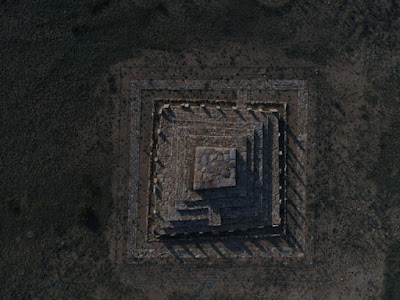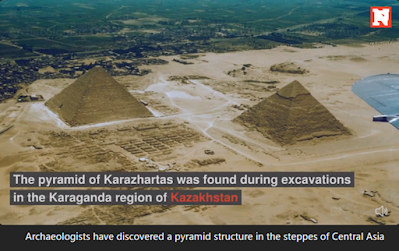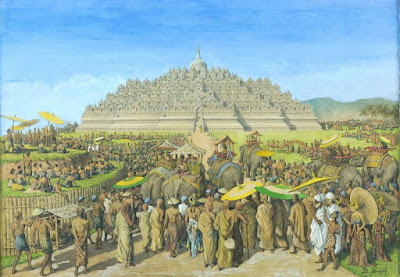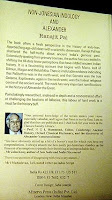 |
| Buddhist pyramid built recently at the Fo Guang Shan headquarters in Taiwan (pinterest.es) |
 |
| This pyramid would be older than the historical Buddha, but Buddhism is older due to the 27 previous buddhas the Buddha talked about in this fortunate kalpa, and would have been from Central Asia (Majjhimedesa) like the cultural features (stupas, kurgans, tumuli) the Buddha was drawing on as a cultural legacy of previous buddhas. |
 |
| Yantra: a mandala disc with sacred geometrical patterns depicting world as a mind map |
 |
| Borobudur, Java: When fully fleshed out, this is a Buddhist pyramid capped by a stupa |
.
Archaeologists discover pyramid built more than 3,000 years ago
Archeologists have discovered a pyramid structure in the steppes of Central Asia that is thought to be more than 3,000 years old.
The monument, known as the Pyramid of Karazhartas, was uncovered during excavations conducted along the Taldy River in the Karaganda region of Central Kazakhstan.
The pyramid was constructed by the Begazy-Dandibai culture, which emerged in Central Kazakhstan during the Late Bronze Age.
 |
| This is the largest excavated Buddhist temple in the world, second to Mes Aynak, Afghanistan |
 |
| Inside the sarcophagus, researchers found a skull belonging to a local ruler who was buried there. This is an aerial view of the step pyramid found on the steppes of Central Asia (© Aibar Kassenali). |
 |
| Borobudur pyramid temple is aligned with Pawon and Mendut Monastery, Central Java |
- Famous Buddhist pyramid of Borobudur, Java, Indonesia
- Buddhism in Central Asia
- PHOTOS: Buddhist Pyramids
- Mendut Buddhist monastery
- Pawon Buddhist Monastery, Java
- Study Buddhism – an extensive source of Buddhist teachings
- World's oldest pyramid -- 10,000+ years old -- found in Indonesia
- Massive pyramid of Indonesia, Gunung Padang, "Mountain of Enlightenment"
- Gunung Padang – Campaka, Indonesia - Atlas Obscura
- Buddhist tombs (stupas) are tumuli (burial mounds) found from Ukraine down to India and in other parts of the world
- Tillya Tepe: Golden Mound Buddhist site
- Stupas are a kind of tumulus, kurgan, barrow
- Resurfaced theory about Stonehenge radically alters view of ancient landmark
- Ice Age Rock Art Discovered Hidden In Amazon Rainforest (msn.com)
- The Buddha was a Saka/Indo-Scythian from ancient Gandhara
- Buddhas of Bamiyan (one of the seasonal capitals of Kapilvastu, the Buddha's home town in modern Afghanistan, Central Asia)
- How the Sakas (Shakyians) honored the deceased
- Eurasians and Proto-Indo-Europeans
- Aržan culture
 |
| Stupa or kurgan of the Sakas (Trizna 1899) |
These communities achieved a relatively high level of economic prosperity thanks to the metal trade that extended to various parts of Eurasia.
 |
| Dr. Pal linked the Buddha |
The high profits from metal exports created a new aristocratic class among the Begazy-Dandibay communities.
The Pyramid of Karazhartas was constructed as a mausoleum for a representative of this aristocratic class, historian Serhan Cinar and archeologist Aybar Kasenali — one of the coordinators of the excavations with the Kazakh National Museum — told Newsweek.
 |
| Unexcavated Mes Aynak ("Copper Hill" Mine) overview East hill, Afghanistan |
 |
| This is a massive and incredible stupa hewn directly into the rock, Mes Aynak |
.
 |
| Buddhist gold coin from Tillya Tepe site |
During the excavations, which were conducted by the Sary Arka Archaeological Expedition of Karaganda University, researchers found that the structure was a square pyramidal mausoleum consisting of step-like layers.
 |
| The Sakas/Scythians were semi-settled nomadic warriors on horseback, experts goldsmiths. |
 |
| Scythian is broad term, East=Sakas |
The mausoleum, which contains a burial chamber, measures around 65 feet by 98 feet across and stands about 5 feet high at its peak. The excavation of monumental stone mausoleums from the Begazy-Dandibai culture began in 1933.
Researchers have since discovered several pyramidal step tombs in the region of the Taldy River valley, in which great leaders were buried.
"The newly discovered Karazhartas stepped pyramidal mausoleum is the largest burial structure of the Begazy-Dandibay elite," Cinar said.
 |
| Pyramid base for stupa, Taiwan |
Investigations at the Karazhartas Pyramid have identified a sarcophagus structure surrounded by granite stones, which was found in the burial chamber.
 |
| Sojiwan Buddhist Temple, SW of Prambanan Hindu Temple, near Borobudur, Indonesia (wiki) |
In one area in the upper part of the burial chamber, archeologists uncovered a bronze arrowhead and a mysterious pottery fragment. Finally, animal bones, which were frequently used in the traditional ceremonies of steppe tribes, were found in various parts of the burial chamber and the step sections of the pyramid.
The features of the tomb, as well as the accompanying items, highlight the high status of the buried individual, according to Kasenali.
Analysis of organic materials found at the pyramid, carried out by Queen's University in the United Kingdom, has enabled researchers to date the pyramid structure to the 15th-14th centuries B.C.
Archeologists also uncovered evidence of a proto-city settlement named Kent in the same region as the mausoleum, which they attributed to the Begazy-Dandibai culture.
Spread over an area of 15 hectares, Kent was characterized by labyrinthine gates, ditches, and walls, according to the researchers.
 |
| Greek culture in Bactria |
The settlement featured a regular, planned street network and water collection systems. And next to the settlement, archeologists found special sacrificial altars where ceremonial offerings to the gods were made.
"In the rituals of the Bronze Age inhabitants of Kazakhstan, offerings were made to the sun, fire, moon, and protective 'ongun' spirits," Cinar said.
The findings at Karazhartas provide detailed information about the historical identity, cultural connections and socioeconomic structure of the Begazy-Dandibay culture, according to Kasenali. More
- Ancient Egyptian tomb discovered with magic spells against snake bites
- Viking bracelet made 1,000 years ago found in farmer's field—'real shock'
- Ancient Egypt's baboon mummies' mystery finally solved
The word kurgan [Buddhist stupa] is of Turkic origin and derives from Proto-Turkic kur- ["to erect (a building), to establish"]. In Ukraine and Russia, there are royal kurgans of Varangian chieftains [the Buddha being raised to be a Shakyian chieftain], such as the Black Grave in Ukrainian Chernihiv (excavated in the 19th century), Oleg's Grave in Russian Staraya Ladoga, and vast, intricate Rurik's Hill near Russian Novgorod. Other important kurgans are found in Ukraine and South Russia and are associated with much more ancient steppe peoples, notably the Scythians (e.g., Chortomlyk, Pazyryk) and early Indo-Europeans (e.g., Ipatovo kurgan) The steppe cultures found in Ukraine and South Russia naturally continue into Central Asia, in particular Kazakhstan. More
Newest Buddhist pyramid, Fo Guang Shan
 |
| Pyramid under Buddha: Fo Guang Shan Buddha Museum 佛光山佛陀紀念館, Taiwan |
.
What does it have to do with the Buddha Shakyamuni (Saka-Muni)?
.jpg) |
| The Buddha was a royal Saka |
However, the Sakas of the Asian steppes are to be distinguished from the Scythians of the Pontic Steppe [8, 11]; and although the ancient Persians, ancient Greeks, and ancient Babylonians respectively used the names "Saka," "Scythian," and "Cimmerian" for all the steppe nomads, the name "Saka" is used specifically for the ancient nomads of the eastern steppe, while "Scythian" is used for the related group of nomads living in the western steppe [8, 12, 13].
While the Cimmerians were often described by contemporaries as culturally Scythian, they may have differed ethnically from the Scythians proper, to whom the Cimmerians were related, and who also displaced and replaced the Cimmerians [14].
 |
| Gandhara Greco-Buddhist art |
In the 2nd century BC, many Sakas were driven by the Yuezhi from the steppe into Sogdia and Bactria and then to the northwest of the Indian subcontinent, where they were known as the Indo-Scythians [20, 21, 22].
Other Sakas invaded the Parthian Empire, eventually settling in Sistan, while others may have migrated to the Dian Kingdom in Yunnan, China.
In the Tarim Basin and Taklamakan Desert of today's Xinjiang Uyghur Autonomous Region, they settled in Khotan, Yarkand, Kashgar, and other places [23]. More
 |
| PHOTOS: Buddhist pyramids are ancient feature and modern feature of temples |
 |
| Four surrounding towers, like minurets, seem to replicate famous Bodhgaya Temple, India |










%20wiki,%20cropped,%20head%20only,%20Wisdom%20Quarterly.jpg)





















































































































































































































































No comments:
Post a Comment